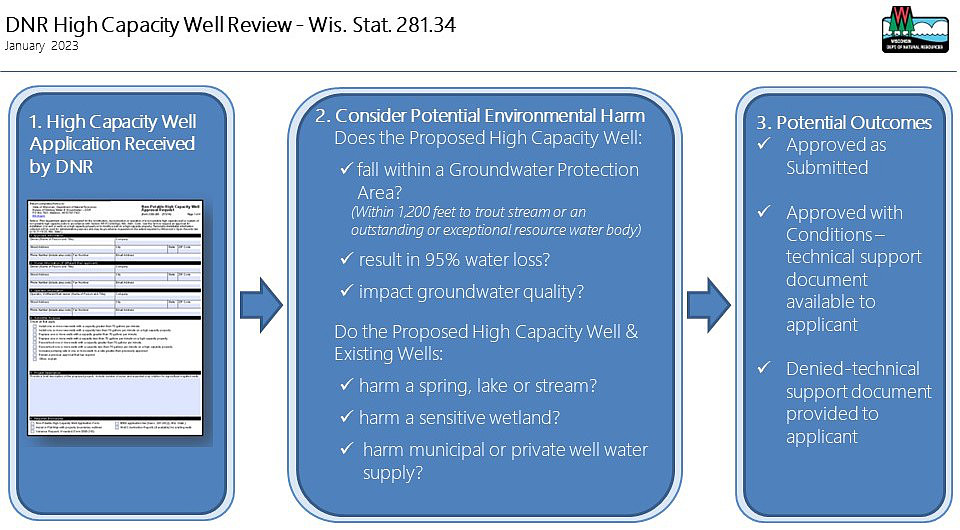High capacity well application review process
Upon receipt of a high capacity well or dewatering application, the DNR water use program completes a groundwater quantity review and reviews the proposed well construction for compliance with the requirements of NR 812, Wis. Adm. Code. If the proposed well is a public well regulated under NR 811, Wis. Admin. Code, the public water engineering program conducts an engineering review.
High capacity well application review
In July 2021, the Wisconsin Supreme Court issued a decision in Clean Wisconsin v. Wisconsin Department of Natural Resources affirming the DNR’s constitutional duty and statutory authority to consider environmental effects on the waters of the state when reviewing high capacity well applications. This decision affirmed the court’s previous ruling in Lake Beulah Management District v. Wisconsin Department of Natural Resources. In accordance with the Supreme Court decision:
- The DNR will consider environmental impacts to the waters of the state when reviewing a proposed high capacity well application.
- The DNR will make a fact-specific determination for each application and will consider the environmental impacts when presented with sufficient concrete, scientific evidence of potential harm to waters of the state. Lake Beulah, 2011 WI 54, ¶ 46.
- Waters of the state are defined as “those portions of Lake Michigan and Lake Superior within the boundaries of this state, and all lakes, bays, rivers, streams, springs, ponds, wells, impounding reservoirs, marshes, watercourses, drainage systems and other surface water or groundwater, natural or artificial, public or private, within this state or its jurisdiction.” Wis. Stat. § 281.01(18)
In reviewing a high capacity well application, the DNR will consider on a case-by-case basis whether:
- A proposed high capacity well falls within a groundwater protection area [Wis. Stat. §§ 281.34(4)(a)1. And (5)(b); Wis. Admin. Code § NR 820.30]
- A proposed high capacity well results in more than 95% water loss [Wis. Stat. §§ 281.34(4)(a)2. and (5)(c); Wis. Admin. Code § NR 820.32]
- A proposed well's construction degrades safe drinking water, degrades the groundwater resource or impacts public safety [Wis. Admin. Code § NR 812.09(4)]
- A proposed high capacity well will result in a significant environmental impact to a spring with a flow of at least 1 cubic feet per second [Wis. Stat. §§ 281.34(4)(a)3. and (5)(d); Wis. Admin. Code § NR 820.31]
- A proposed high capacity well, when combined with existing wells, will result in potential harm to waters of the state. [Wis. Stat. §§ 281.11, 281.12, 281.34, and 281.35; Lake Beulah, 2011 WI 54, ¶ 44; Clean Wisconsin, 2021 WI 72, ¶¶ 17-19]
- A proposed high capacity well impairs the water supply of a public utility. [Wis. Stat. § 281.34(5)(a); Wis. Admin. Code § NR 812.09(4)(a)1.]
If any of these situations exist in a particular case, the DNR may consider adding specific conditions in the high capacity well approval, such as conditions addressing location, construction, pumping capacity, rate of flow, or amount of water that may be withdrawn. If the DNR conditions or denies a well approval, it will provide the applicant with a technical analysis of the scientific evidence it considered in its decision.


